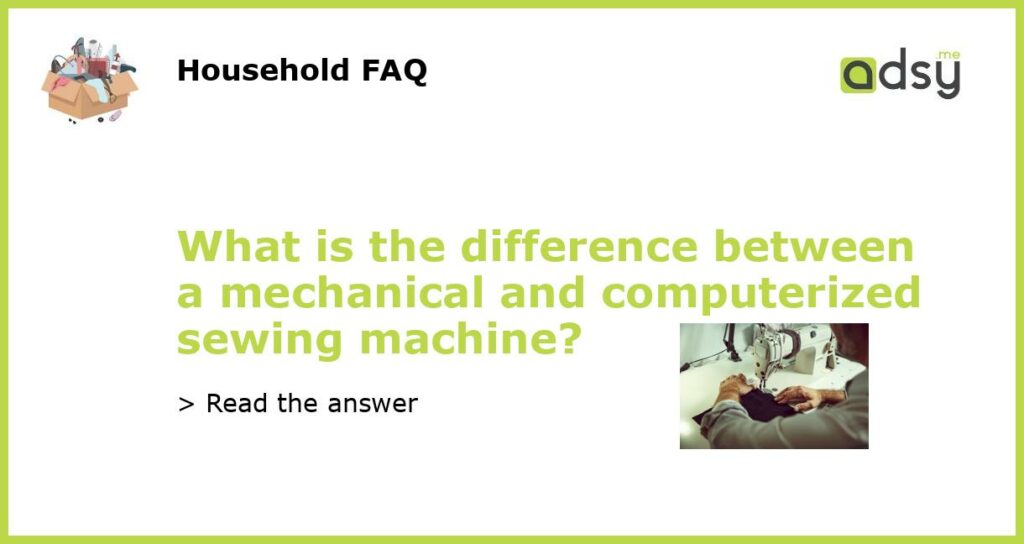Mechanical vs Computerized Sewing Machines: Understanding the Differences
When it comes to sewing machines, there are two main types to choose from: mechanical and computerized. While both machines serve the same purpose – to sew fabric – they differ significantly in terms of features, functionality, and ease of use. If you’re new to sewing or looking to upgrade your current machine, it’s important to understand the differences between these two options so you can make an informed decision. In this article, we will delve into the disparities between mechanical and computerized sewing machines.
Mechanical Sewing Machines: Simplicity and Reliability
Mechanical sewing machines have been around for decades and have a long-standing reputation for reliability and simplicity. These machines are operated using mechanical components, such as gears, levers, and knobs, rather than electronic controls. They are generally more affordable and easier to maintain than computerized machines.
With a mechanical sewing machine, you have more control over stitch settings as you manually adjust tension, stitch length, and stitch width using the designated knobs and dials. This can be advantageous for experienced sewers who prefer hands-on control and versatility
However, mechanical machines can be more challenging for beginners due to the learning curve associated with setting the correct stitches and tension manually.
Computerized Sewing Machines: Precision and Convenience
On the other hand, computerized sewing machines are equipped with advanced technology and electronic components, making them more precise and convenient to use. These machines feature a digital display and built-in computer programs that allow for easy stitch selection and customization.
Computerized machines offer a wide range of automatic functions, such as automatic thread cutting, needle positioning, and even thread tension adjustment. They also have a larger stitch library, with pre-programmed decorative stitches and embroidery patterns, providing sewers with limitless design options.
One of the main advantages of computerized machines is their ability to save and recall stitch settings. This allows you to effortlessly switch between different stitches and stitch combinations without having to manually adjust settings each time.
Ease of Use and User-Friendliness
When it comes to ease of use, computerized sewing machines have the upper hand. They are designed with user-friendly interfaces, intuitive controls, and clear digital displays, making them more accessible for beginners and those who prefer a more simplified sewing experience.
Mechanical machines, on the other hand, require a bit more skill and patience to master. As mentioned earlier, you need to manually adjust tension, stitch length, and other settings, which can take some time to get used to. Additionally, mechanical machines may not have as many automatic features, making certain tasks more labor-intensive.
Price and Affordability
When it comes to cost, mechanical sewing machines are generally more budget-friendly than their computerized counterparts. Since mechanical machines have simpler construction and fewer electronic components, they tend to have a lower price tag.
Computerized sewing machines, on the other hand, generally come with a higher price due to their advanced technology, automatic features, and larger stitch libraries. However, if you consider the convenience and versatility they offer, the investment may be worth it for more experienced sewers or those who plan to use the machine extensively.
Which Sewing Machine Should You Choose?
The choice between a mechanical and computerized sewing machine ultimately depends on your personal preference, skill level, and sewing needs. If you’re a beginner or value simplicity and reliability, a mechanical machine may be the best option for you. On the other hand, if you enjoy the convenience of automatic features and want more creative possibilities, a computerized machine would be a better fit.
Consider your budget as well. If you’re on a tight budget, a mechanical machine may be a more affordable choice. However, if you’re willing to invest in a high-quality, feature-rich machine, a computerized model can offer a more enjoyable and efficient sewing experience.
Whichever you choose, learning how to operate and maintain your sewing machine properly is essential. With practice and the right machine, you can hone your sewing skills and create beautiful garments, crafts, and home decor items.






